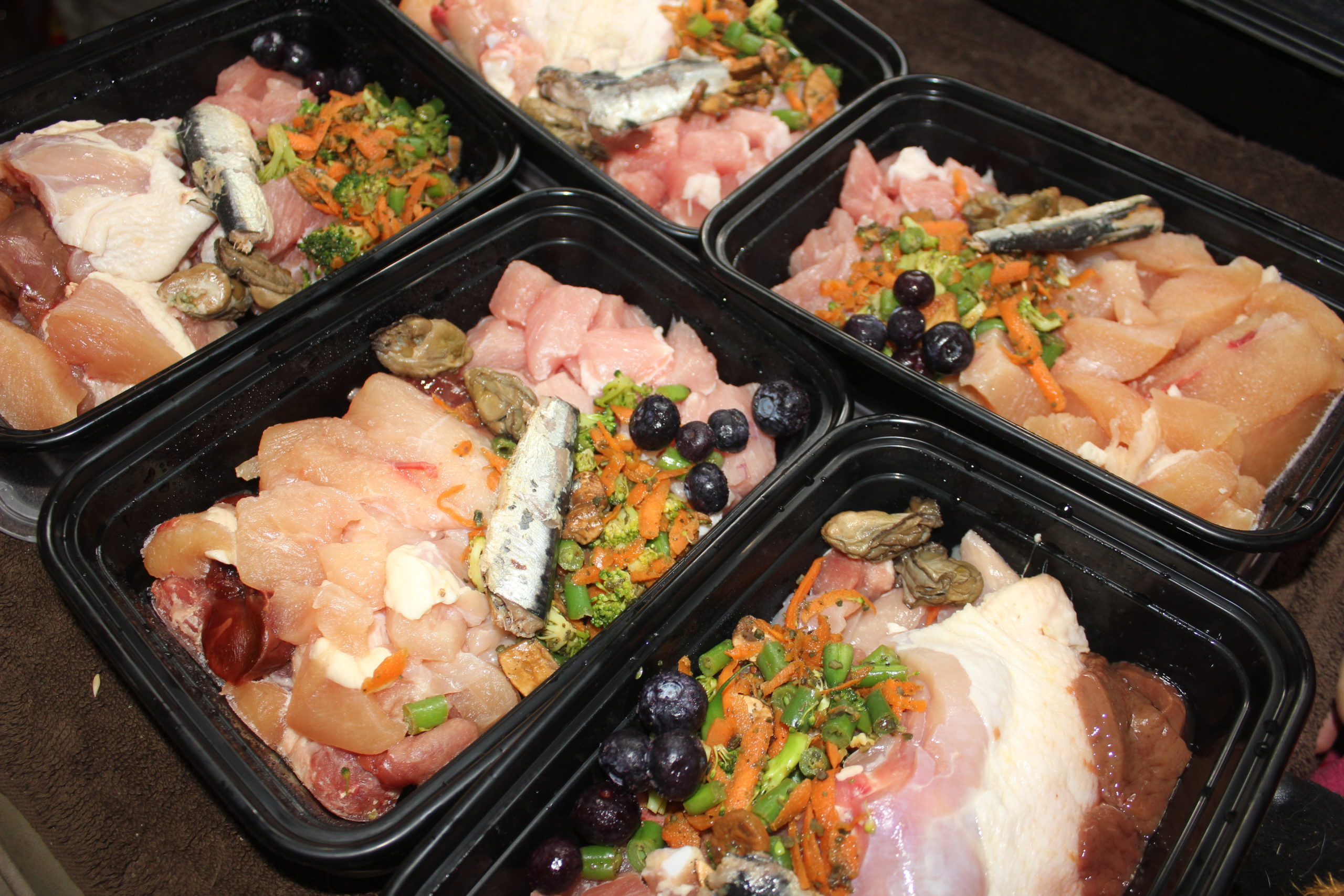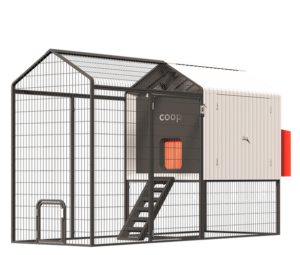I used to think that dogs were omnivores just because they will eat other things. But they are actually carnivores. Dogs thrive on a carnivorous diet, but they can survive on other food sources in times of scarcity. So, when a wolf eats grass or berries out of desperation, it’s simply to survive and it isn’t necessarily the best thing for them. Meat is what will make a dog/wolf thrive!
Domesticated dogs fed a homemade diet don’t get the fur and such from an animal in their diet. Vegetables help provide the fiber lacking from the absence of these, as well as provide trace vitamins and minerals. That’s not to say you should be going out and buying animal hides to cut up and feed to your animals which would be full of harmful additives. But for example, we raise meat rabbits for our dogs, and we’ll toss in an ear or foot with the hair still on it for the little bit of added fiber.
I don’t tend to feed my dogs the same thing repeatedly. I like to mix things up to provide variety, and ultimately a balanced diet. But if you prefer a nutritionally stable recipe, there’s a couple good ones by Dr. Karen Becker on YouTube (links provided below). She also has a good video series on YouTube that focuses on raw food diets and the many misconceptions on it.
YouTube: Beef Recipe
https://www.youtube.com/watch?v=7P85BMCCboI
YouTube: Chicken Patty Recipe `
https://www.youtube.com/watch?v=kzgfy8L-Iis
BARF vs. PMR Diet Models, What’s The Difference & Which Is Better?
To put it simply, BARF stands for “Biologically Appropriate Raw Food”, and PMR stands for “Prey Model Raw”. They are both essentially the same with some minor differences. The BARF diet includes a small amount of veggies and fruit with maybe a little bit of dairy in it, while the PMR diet is strictly meat and includes feeding the whole carcass. This including the odd ball stuff like fur, stomach, hooves, etc. Ideally, I feel the PMR diet is the best one. Everything is bioavailable to your pet and already balanced with nutrients provided you are rotating your proteins. However, not everybody can stomach giving their dogs/cats that type of diet. So BARF diets are the next best thing. If you follow Dr. Karen Becker, she stresses the importance of providing veggies both for roughage, fiber, and additional vitamins and minerals that may be missing from meat alone. She’s stated there’s research finding that wolves have had up to 30% vegetable matter in their stomachs.

Base Ingredients For One Meal
Here I have the base ingredients of meat/vegetables/fruit to cherry pick from so you can provide your pet all sorts of fun new combinations. The “Optional Add Ins” will help to make the prepared meals more nutritionally balanced and complete. Note that these proportions don’t have to be 100% accurate each day, but it is important that there is a balance of nutrition over the course of a week.
Meat
You’ll Need . . .
80-85% Muscle Meat
Rabbit
Poultry
Beef
Goat
Lamb (must freeze for 24 hours prior to feeding to kill parasites)
Venison (must freeze for 24 hours prior to feeding to kill parasites)
Pork (must freeze for 3 weeks prior to feeding to kill parasites)
Fish (salmon must be frozen for 2 weeks prior to feeding to kill parasites)
Also Includes: Hearts, Gizzards, Lungs, Trachea, Tongue, Green Tripe
5-10% Organ Meats (5% liver, 5% other)
Liver
Kidneys
Spleen
Brain
Testicles
10% Bones or alternate calcium source like ¾ tsp eggshell powder per cup of meat
10-30% Vegetables
*Lightly steamed, grated/finely chopped, fermented, or blended to improve digestibility.
Broccoli
Carrots
Bell Peppers
Leafy Greens (especially Kale)
Green Beans
Zucchini
Squash
Other veggies may be fine to use (look them up first). These are the common ones I use that should be okay to feed every day.
Fruit (optional – about 2 tablespoons berries per day for 60 lb dog)
Berries are best! (strawberries, blueberries, raspberries)
Though there are several other fruits that are dog friendly like apples and bananas, they are not as nutrient dense and mostly just add sugar to your pet’s diet.
Grains: NOT NEEDED, Dogs do not process or digest these well.
Optional Add Ins: Amounts are for about a 60 pound dog per day.
1 Egg (only use a couple times per week, too much raw egg can inhibit absorption of biotin, cooked is fine to feed more frequently)
2 Sardines (canned in water, provides Vit. D & Omega 3’s)
Pinch of Kelp/Iodized Salt (for iodine and trace minerals)
Tsp Ginger (manganese, anti-inflammatory)
1 Clove Garlic (immune boost, anti-parasitic)
Tsp Turmeric (anti-inflammatory)
Tsp Apple Cider Vinegar w/Mother (good for joints, digestion, balance pH . . . )
Tsp Coconut Oil (shiny coat)
Tsp Flaxseed (fresh ground, provides ALA)
Tbs Pumpkin Seeds (raw, fresh ground, provides vit E & manganese)
100% Pure Pumpkin Puree (good for diarrhea and constipation)
1 Oyster (canned in water, provides Zinc)
Cranberry Capsules (urinary health)
Pinch of dried herb or Tbs fresh (Basil is common and provides manganese, iron, vit K)
Tbs Nutritional Yeast (possible allergen but provides B vit., trace minerals, vitamins, amino acids, possible pest repellent when fed regularly)
*Green Tripe (Nutritional Powerhouse! Feed as a muscle meat, provides natural enzymes and probiotics that aid in the digestion of vegetables.)
Homemade Vitamin Mix (From Dr. Karen Becker): Click Here
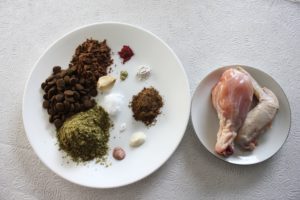
Nutritional Deficiencies
Nutritional deficiencies are common on a homemade raw diet if they are not put together properly. This is partially why vets aren’t especially keen on such diets. A helpful post I found for these deficiencies can be found here. Dr. Karen Becker has a book that can help you with designing nutritional complete meals, found here. A whole prey meal plan where you feed the WHOLE animal (guts, brain, blood, eyes, fur, feather, etc) should be nutritionally complete. This is as long as you are rotating different animal proteins. Much easier, but more primal.
Why Feed Raw? Is It Really Worth The Added Cost & Effort?
This depends on how much you truly value your furry canine/feline companion(s) and if you have the time and money to do it. Some may argue that their dog does just as well on a diet of kibble, and therefore there’s no need to invest in feeding their dog(s) a raw diet. When you look at dogs as a whole these days there’s been plenty of allergies and health issues that have been corrected by changing to a raw food diet. You wouldn’t want to put low-quality fuel in an airplane, would you? I wouldn’t think so, most of us would like to be able to rely on that airplane to last and make it through its flight without an issue. It comes back down to surviving on a lesser quality food vs thriving on a quality diet. The many health benefits of feeding raw include . . .
-Shinier Coat
-Whiter Teeth
-Better Performance
-Better Joint Health
-Improved Behavior
-Increased Longevity
-Decreased Vet Bills
-Aids In Elimination Of Allergies & Other Health Problems
-Smaller/Fewer Poops
How Many Meals Should Your Dog Have On A Raw Diet?
Dogs in the wild don’t have the luxury of eating 2-3 meals per day in nicely prepared meals. In fact, they’re lucky if they get to eat a couple of meals a week. So, unless you have a young puppy who need to eat more frequently, I believe that one meal per day for your dog or cat is plenty. This allows your pet to fully digest their raw meal and have a short fast time until the next meal. When you are feeding your dog too frequently, their systems don’t have a chance to reset and repair themselves (this applies to us too). However, puppies and young active dogs that eat larger quantities should be split into 2-3 meals. Large breed dogs should not eat any more than 1.5-2 pounds in a meal to prevent bloat.
On a kibble diet however, it’ s better to split their food into 2 meals for safety concerns. Kibble expands in the gut, so if you have a large dog eating 6 cups of kibble per day and you try to feed that in one meal, that will expand to at least 12 cups in their stomach. In a raw diet, the amount doesn’t change size in the gut, and it’s a lot less food to begin with.
How Much Raw Food Do I Feed My Dog?
A good rule of thumb is to feed your dog 2-3% of their body weight. But, there’s going to be a lot of variances between different proteins, how many veggies you are feeding, how much fat is in the diet. It’s best to go off of how your dog looks. If your dog is already a healthy weight, try feeding 2% of their body weight and adjust as needed if they start to gain or lose weight. My dog is 60 lbs, so he eats about 1.5 lbs or so depending on his activity level.
Raw Dog/Cat Food Calculator By Blue Ridge Beef Here
A Note On Raw Bones
If your dog has never had raw bones before, don’t just toss them a bone and leave them to it. Many dogs have ended up at the vet for this. Supervise your dog to make sure they are chewing them properly and not swallowing large or sharp pieces. Also make sure that you are getting bones that are the appropriate size for your dog. A large dog should not be chewing on a rib bone that they can easily take chunks off of. They should have large knuckles bones that provides more of a gnawing action. After they finally grind it down to a size they might try to swallow whole then take the bone away and toss it. NEVER give your dog cooked bones, they shatter into sharp pieces much more easily.
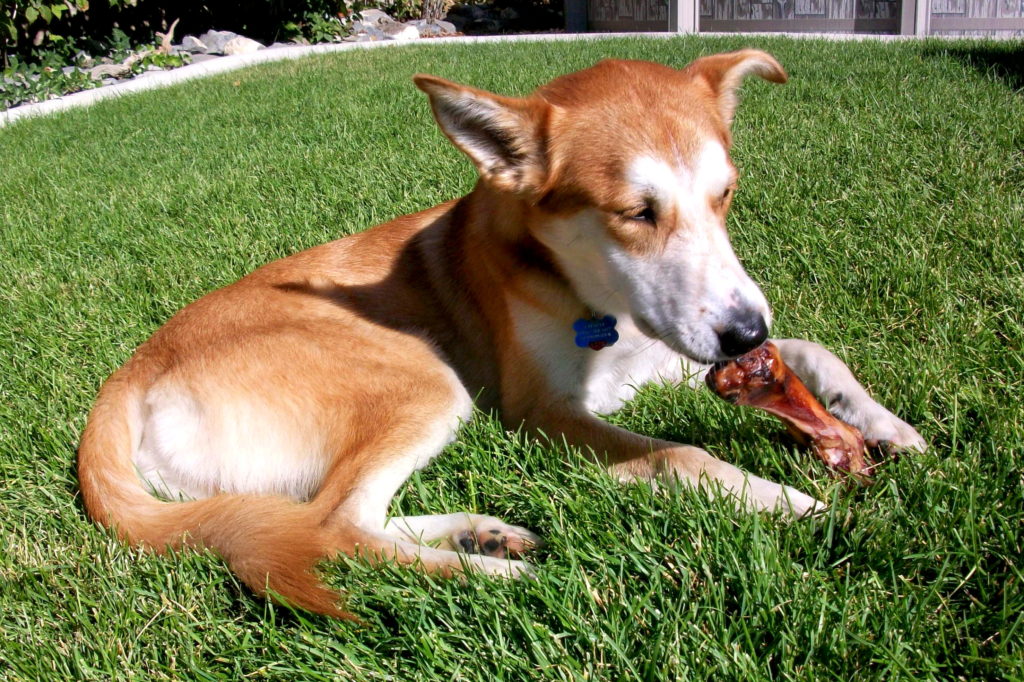
Transitioning From Kibble
Starting your dog on a raw diet can take some time to do, especially if they’ve lived on kibble their whole life. But the overall benefits are worth the effort. You might want to start with adding cooked meat to your dog’s food before trying the raw. If your dog seems to be handling it well then you can increase the amounts until they are completely raw. If they get digestive upset or diarrhea, then ease up on the amounts until their system adjusts. Once they are fully raw you can begin to gradually add some of the richer organ meats until they can handle those too.
When you change your dog’s diet, you’re also changing their gut flora. So, give their system time to create that new flora and adjust to the new food source (this can take up to a year for some).
UPDATE: I’ve heard additional information that you should NOT mix kibble with raw as they digest at different rates and can cause bacteria build up in the gut. It’s been recommended that you simply fast you dog the day before switching them over to raw. I would say another option, if you prefer the gradual method, is to feed kibble separate from raw. Maybe feed kibble in the morning, and raw for dinner, until you dogs system adjusts to the raw food.
Is Feeding Raw Expensive?
Feeding your dog raw can be inexpensive if you know where to look for your ingredients. Organ meats are generally quite cheap, it’s going to be the main muscle meats that are going to be your main expense. Try . . .
Grocery Store: The grocery store is going to be the most expensive of the options, but it’s also the most convenient if you already do your shopping there. Meat goes on sale all the time at grocery stores if they aren’t selling it quick enough. Maybe contact the meat department and see about having them set discounted meat aside for you. More likely though you’ll just need to check in frequently for deals.
Local Butcher: Going to an actual butcher, you’re more likely to find a variety like chicken backs, turkey necks, organ meats, ect. and at a cheaper price. With the mom and pop shops, you may be able to strike up a deal if you purchase from them regularly. Smaller shops will also have more leniency when it comes to selling older meats vs the big box store chains who have more strict rules and regulations to follow.
Online: There’s an increasing number of online options for buying raw dog food though it’s not an option that I have tried. I’ve found that it tends to cost more, especially with added shipping costs. And personally, I like to hand pick out my dogs’ food.
Craigslist: This may be one of the least appealing options for many. But, if you’re following a PMR style of raw feeding, keep an eye on your local listing for free rabbits, chickens, or other livestock. This requires you to dispatch the animal yourself, but it’s also a budget friendly option. I haven’t actually done this option myself, but my recommendation would be to pick out healthy animals and respect peoples desires to not see the animal(s) used for food. Some sellers just want their animal to find a good home and not be killed for meat.
Meat Processing Plant: These are the places that process hunting game like deer and such. Some even process local farm animals. I have found this to be the ideal option to seek out some killer deals. Many people that bring animals in for butcher, are not going to be interested in keeping the organs, bones, or stomach (tripe). That puts those parts up for grabs where they would otherwise be tossed out. Or if you’re lucky, and they only want the hide, that also puts the meat up for grabs. Just be careful with wild game, you’ll want to freeze the meat for a couple of days to kill any possible parasites. With zombie deer disease going around I wouldn’t dare feed my dog deer at this time unless it’s been tested.
Raise Your Own: If you have the space and are zoned for it. Try raising meat rabbits, chickens, or goats. If you have kids, it can be fun for them to raise them and create a learning experience to know your meat source, and you get the whole animal. With rabbits, they are fairly cheap to feed, and one male to two females makes more meat in one year than a cow. We raise milking goats, but there’s been a couple of times where we couldn’t sell the bucks and didn’t have the space for them. We ended up having to process them and fed the meat to the dogs. The cost to process the goats was equivalent to that of buying dry dog food. It could have been even cheaper if we were willing to do some of the processing ourselves.
Only Go Part Raw: If going full raw is too expensive, then only feed partial raw here and there when you can afford it. You can add bits of raw here and there to their kibble, though I’ve heard it’s best not to mix the two as they are digested at different rates and therefore can mess with your dog’s digestive system. To remedy this, I’ll feed an all-raw breakfast, and then feed a kibble dinner so the two aren’t mixed up. This will also make it easier if you ever have to go out of town. The person watching your dog can have the convenience of just feeding the kibble since the dog’s system is still used to it. We always have a bag of kibble around for those times when we’re traveling, or we run out of raw. Some raw is better than none and is ultimately better for your dog’s health.
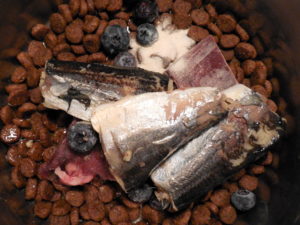
Common Sense Raw Dog Food HERE
Have a cat too? View my other post “Guide To Feeding Your Cat A Raw Food Diet“.

